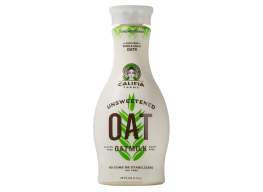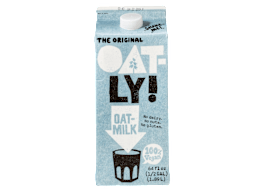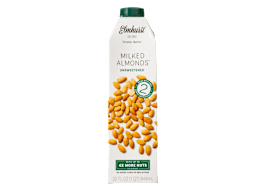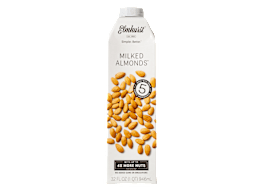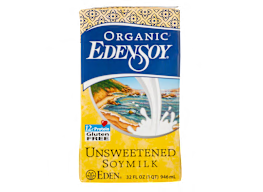Is Milk Good for You?
It's not just dairy vs. plant-based milk: There are more options in the milk aisle than ever. Here's how to find the right drink for you.
It used to be that milk was one of the most straightforward drinks out there. You could choose whole, low-fat, or skim—and that was it. But over the past 10 to 15 years, the milk aisle has gotten considerably more crowded with a mind-boggling variety of dairy milk (A2, grass-fed, ultrafiltered) and plant milk (oat, almond, sesame seed).
According to a 2023 Consumer Reports nationally representative survey (PDF) of 2,121 U.S. adults, 79 percent still buy cow’s milk. But people are drinking a lot less of it. Per capita consumption has declined by 28 percent in the past 20 or so years, from 8.2 gallons per person per year in 2000 to 5.9 gallons in 2021, according to the Department of Agriculture. At the same time, sales of plant-based milk have been increasing. In 2022, 41 percent of households had purchased plant milk, according to a market analysis by the Plant Based Foods Association. Of all the milk sold, 15 percent is now plant milk, the report said.
To keep up with the growing market for plant milk, the dairy industry has promoted what it claims are healthier and more sustainable cow’s milk options. Meanwhile, on the plant milk side, more choices with added nutrients and better taste have made going dairy-free more appealing.
Dairy Details
There’s a lot of conflicting information about dairy milk floating around. It has been positioned by some as a near-perfect food, necessary for bone health. But others say it’s a cause of everything from inflammation and heart disease to digestive disorders and bad skin. The truth is, cow’s milk has mostly benefits and just a few drawbacks.
On the plus side, it’s a concentrated source of important nutrients. One cup supplies 8 grams of protein, about a quarter of the daily value for calcium, and 14 percent of the daily value for vitamin D, and it provides magnesium, potassium, zinc, and more.

Cows that graze exclusively on grass produce milk that has more heart-healthy omega-3 fatty acids than regular milk. But you’d have to drink about 3 cups of whole milk to get just 19 percent of a man’s daily needs (27 percent for women), so it shouldn’t be your only source. Grass-fed milk can have an earthy flavor. It’s also pricey: A half-gallon of organic grass-fed at Target costs $6.49, compared with $3.99 for regular organic. Look for the American Grassfed seal, which CR considers to have excellent standards.
- Calories: 120
- Sat. Fat: 3 g
- Carbohydrates: 12 g
- Protein: 8 g
- Calcium: 290 mg
- Vitamin D: 2.5 mcg
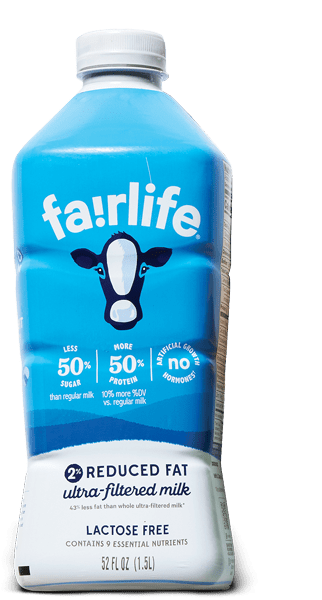
An extra processing step filters out some water and some of the lactose. This concentrates the milk, making it higher in protein and lower in sugar, and gives it a thicker, creamier texture. Companies also add lactase, the enzyme that breaks down any remaining lactose into simple sugars, a step that creates a sweeter flavor than regular milk. Because it’s thicker than regular milk, it may not work as a 1:1 swap in recipes. At Walmart, a 52-ounce carton costs $4.18; 64 ounces of regular milk costs $1.73.
- Calories: 120
- Sat. Fat: 3 g
- Carbohydrates: 6 g
- Protein: 13 g
- Calcium: 380 mg
- Vitamin D: 5 mcg

Typically, this process is used on organic milk to extend its shelf life. The milk is heated to a higher temperature during pasteurization than regular milk. This kills more of the bacteria that can make milk spoil. (Regular pasteurization mainly kills bacteria that can cause illness.) Once you open the carton, though, you should still consume it within seven to 10 days like any other milk. As for nutrition, it’s no different from regular dairy milk, but some complain that it has a “cooked” flavor.
- Calories: 130
- Sat. Fat: 3 g
- Carbohydrates: 12 g
- Protein: 8 g
- Calcium: 291 mg
- Vitamin D: 3 mcg

If your body doesn’t produce enough lactase—the enzyme that breaks down the lactose in milk—you may experience bloating, gas, and diarrhea when you drink dairy milk. Lactose-free milk has lactase added, so it’s easier to digest for those who are lactose-intolerant. It has the same nutrients as regular milk, but it tastes a little sweeter. Use it like regular milk (but you might not need to add any sugar to your coffee).
- Calories: 130
- Sat. Fat: 3 g
- Carbohydrates: 13 g
- Protein: 8 g
- Calcium: 300 mg
- Vitamin D: 2.5 mcg

People often assume that any stomach upset after drinking milk is due to lactose intolerance. But if lactose-free milk still bothers your belly, you may want to try A2 milk. Regular milk contains A1 and A2 proteins; A1 has been linked with GI symptoms and inflammation in some people. A2 milk comes from cows that don’t produce the A1 protein, so it can be easier to digest. (A2 milk still contains lactose, so it won’t help those with lactose intolerance.) It also costs more: At Shaw’s, 59 ounces is $4.99, while 64 ounces of regular milk is $2.69.
- Calories: 120
- Sat. Fat: 3 g
- Carbohydrates: 12 g
- Protein: 8 g
- Calcium: 298 mg
- Vitamin D: 2.5 mcg
The Lowdown on Plant Milk
Almost half of people who buy plant-based milk do so because they think it’s better for them or has more of the nutrients they need than cow’s milk, and 39 percent think it’s better for the environment or protects animals, according to CR’s survey.
But many experts say that plant-based milk isn’t more healthful than dairy milk. Soy milk comes the closest to dairy, as long as it’s fortified with calcium and vitamin D. “Most other plant-based products do not contain nutrients comparable to dairy milk,” says Emma Laing, PhD, director of dietetics at the University of Georgia in Athens. Keep these points in mind:
• Choosing plant milk instead of dairy can mean you’ve lost one of your diet’s top sources of calcium. Plant-based milk doesn’t contain much calcium naturally. If your diet doesn’t have other calcium sources, look for plant milk fortified with at least 300 mg, roughly the same amount as in a cup of dairy milk.
• A cup of cow’s milk has 8 grams of satisfying protein. Many plant-based milks will have only around 1 gram per cup unless they’re fortified with isolated protein, which is a highly processed ingredient. That said, there’s a lot of variety among brands, so be sure to check labels. Elmhurst’s Unsweetened Milked Almonds, for example, has 5 grams, all from almonds. (The company uses more nuts per serving than other brands.) And soy milk is the one consistent exception, with almost the same amount of naturally occurring protein per cup as dairy milk.
• Most of the dairy milk in the U.S. is fortified with about 3 micrograms of vitamin D per cup, making it an important source of the nutrient. (The daily value is 20 mcg.) If you’re opting for plant-based milk, look for one fortified with about the same amount.
• Some plant milk may contain additives like sweeteners and thickeners. Unless you seek out unsweetened varieties, you may be getting as much as 13 grams of added sugars per cup. (The American Heart Association says men should have no more than 36 grams per day; women, 25.) And thickeners and stabilizers—like carrageenan, xanthan gum, and guar gum—which help give plant milk a consistency like dairy milk, may be problematic for certain people. “Some studies have shown an adverse association between these additives and inflammation in the GI tract,” Laing says. If you notice gastrointestinal discomfort after drinking plant-based milk, try additive-free options, such as those made by Elmhurst and Malk.
Plant milk does have an edge when it comes to sustainability. Its production creates 62 to 78 percent less greenhouse gases than dairy milk and uses less water and land resources, according to a 2023 report in the journal Current Environmental Health Reports. But not all plant milk is equally environmentally friendly. According to a 2022 study published in the journal Sustainability, oat and soy milk are the best for the planet.

Among all plant milks, soy contains the most protein, vitamins, and minerals, coming the closest to dairy milk in nutritional value. And when Food and Drug Administration researchers analyzed 85 plant-based milk samples, soy milk stood out for being high in several minerals found in dairy milk. Soy milk has a slightly sweet, nutty flavor that can work well in coffee, with cereal, or for drinking.
- Calories: 80
- Sat. Fat: 0.5 g
- Carbohydrates: 4 g
- Protein: 7 g
- Calcium: 300 mg
- Vitamin D: 3 mcg

Oat milk’s mildly sweet flavor, thickness, and natural creaminess make it a good substitute for dairy in soups, coffee drinks, and baking. It’s higher in carbs than dairy milk and most other plant-based milks, supplying as much as 17 grams per cup of unsweetened versions. (Dairy milk has 12 grams per cup.)
- Calories: 100
- Sat. Fat: 0 g
- Carbohydrates: 12 g
- Protein: 1 g
- Calcium: 260 mg
- Vitamin D: 4.4 mcg

Coconut milk has more saturated fat than other plant-based milks and about the same amount as whole cow’s milk. But some of those fats are medium-chain fatty acids, which don’t seem to be linked to heart disease. Its taste is mild, with a slightly tropical twist. Just make sure you’re buying coconut milk in a carton rather than canned; the canned type is thicker, higher in fat, and better used in cooking than as a drink.
- Calories: 45
- Sat. Fat: 3.5 g
- Carbohydrates: 2 g
- Protein: 0 g
- Calcium: 130 mg
- Vitamin D: 2.5 mcg

Slightly sweet, nutty almond milk is widely available. It tends to be lower in calories than most other plant-based milk. It’s not as eco-friendly as other plant milks because it takes a lot more water—even more than dairy milk—to produce. Perfect for smoothies: Its mild flavor lets other ingredients shine.
- Calories: 30
- Sat. Fat: 0 g
- Carbohydrates: 1 g
- Protein: 1 g
- Calcium: 450 mg
- Vitamin D: 5 mcg

This milk has an earthier, richer flavor and thicker texture than some other plant-based options. Use in soups, sauces, and other recipes you might use cream in. It’s also an easy plant-based milk to make at home. Soak 1 cup of raw cashews in water overnight and drain. Combine in a blender with 4 cups of water and a pinch of salt; add vanilla or a date to sweeten, if desired.
- Calories: 130
- Sat. Fat: 1.5 g
- Carbohydrates: 7 g
- Protein: 4 g
- Calcium: 15 mg
- Vitamin D: 0 mcg

This milk has a toasty flavor and a nutrition profile similar to that of other milks. Some options contain up to 8 grams of protein, but it’s not all naturally found in the milk; rather, it’s added pea protein. Because it’s newer to the market, you may have a hard time finding sesame milk in local stores. The sesame plant doesn’t require a lot of water to grow and is naturally heat-resistant—so it’s a good bet for sustainability. Pairs well with cereal and fruit.
- Calories: 90
- Sat. Fat: 0.5 g
- Carbohydrates: 2 g
- Protein: 8 g
- Calcium: 390 mg
- Vitamin D: 5 mcg
@consumerreports Reminder: Don’t drink raw milk. See other food safety advice through the link in our bio. #foodsafety #healthtok #groceries
♬ original sound - Consumer Reports
Editor’s Note: This article also appeared in the September 2023 issue of Consumer Reports magazine.

















